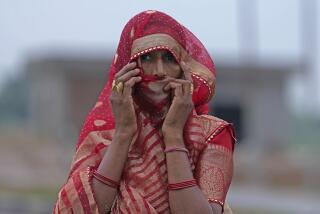A Deal Averts Face-Off in India
- Share via
AYODHYA, India — A local official and the 92-year-old leader of a nationalist movement to build a Hindu temple on the site of a demolished mosque reached a last-minute compromise today that was expected to avert a confrontation with heavily armed police.
Before the agreement, the Hindu holy man, Ramchandra Das Paramhans, sought the advice of his doctor and divine inspiration Thursday as he prepared to challenge police roadblocks.
Das had told disciples in this northern Indian town that he would lead a procession this afternoon toward the site of a mosque demolished by a Hindu mob nearly a decade ago and would try to lay symbolic claim to it.
But today, he agreed to a peaceful procession to a spot about 650 yards from the site.
“Yes, there is no formal compromise as such, but Ramchandra Das Paramhans has agreed to donate a shila [a carved temple stone] outside the disputed area, which doesn’t violate the honorable Supreme Court’s judgment,” Anil Kumar Gupta, the local administrator in charge of the region, said in an interview this morning. Gupta added that he had permission from state and local governments to accept the plan.
On Wednesday, India’s Supreme Court banned any religious ceremonies on a 67-acre site that includes the ruins of the 16th century mosque, whose destruction in December 1992 sparked nationwide violence that killed more than 2,000 people.
In recent weeks, more than 650 people, most of them Muslims, died in communal violence in the western state of Gujarat after a Muslim mob set fire to a train carrying Hindu activists from Ayodhya. The blaze killed 58 passengers.
Hindu nationalists claim that the site is the birthplace of Lord Rama, an incarnation of the god Vishnu, and want to build a temple there.
Police detained at least 100 supporters of the Ram temple movement this morning, mostly young men, who were bused away from Ayodhya chanting, “Long live Lord Rama!” But the town remained calm.
Gupta told an Indian television network Thursday that he would allow Das and his followers to carry the shila in the vicinity as long as they abide by the court order to stay away from the site where the mosque stood.
Leaders from across India’s broad political and religious spectrum had pleaded for Das to back down from the confrontation in Ayodhya, where about 2,000 of his followers threatened to provoke clashes that could spread across a nation of 1 billion people.
Das sat cloistered in a small, windowless room Thursday evening, and his doctor checked his blood pressure.
Monkeys playfully scrambled over the corrugated tin roof of the quarters where Das, guarded by several police officers with rifles, met with his nephew and secretary. The two disciples held Das under each arm when he emerged briefly and hobbled to an outdoor toilet.
About 50 Hindu devotees kept constant vigil, milling about or sitting on red plastic patio chairs as musicians chanted to Rama while they played cymbals, a harmonium and a tabla next to a ceremonial fire.
The state and federal governments have deployed about 8,000 police and paramilitary forces, armed with rifles, tear gas and water cannons, to Ayodhya and have closed off the main routes into town to anyone without two official permits.
Ayodhya has a population of about 60,000, including the Hindu pilgrims, and it is now the most heavily policed place in India, with more than one officer to control every eight people. In the narrow streets closest to a Hindu stone masons’ workshop Thursday evening, there were more police officers than civilians.
Even without the late agreement, the overwhelming show of police force probably would have been enough to keep Das and his disciples well away from the site of the destroyed mosque, or Babri Masjid.
The violence unleashed by the destruction of the Babri Masjid left wounds in the national psyche that have yet to heal.
The mosque was destroyed after Hindu nationalists were allowed to hold a prayer ceremony at the site in exchange for assurances that they would be peaceful.
An estimated 140 million Indians are Muslims, and while the majority of Indians are moderate and tolerant of different religions, communal tensions are a constant danger.
If authorities fail to keep the peace in Ayodhya, the shock waves could bring down Prime Minister Atal Behari Vajpayee’s government just as India and Pakistan are locked in a dangerous military standoff on their border and in the disputed region of Kashmir.
Vajpayee already is under fire from smaller parties within his ruling coalition, and from the opposition Congress Party, because his attorney general argued in the Supreme Court that proponents of the Hindu temple should be allowed to pray next to the site of the demolished mosque.
The Supreme Court rejected that proposal, and Vajpayee vowed to enforce the court’s judgment even though it put the prime minister at odds with some of his strongest political supporters.
Ayodhya is in the eastern part of Uttar Pradesh, India’s most populous state and a political stronghold of Vajpayee’s Hindu nationalist Bharatiya Janata Party until the group suffered a humiliating loss in elections last month.
The BJP controlled the state government when the mob demolished the mosque in 1992, and the Congress Party federal government at the time blamed state officials for allowing it to happen.
In February 1993, a 122-page federal government report held Uttar Pradesh’s then-chief minister, Kalyan Singh, a BJP leader, responsible for the mosque’s demolition and said he apparently ordered local police and officials not to intervene.
The BJP responded with a report of its own, which trumpeted extremist Hindu views that the moderate Vajpayee has worked hard to quiet, at least in public.
More to Read
Sign up for Essential California
The most important California stories and recommendations in your inbox every morning.
You may occasionally receive promotional content from the Los Angeles Times.













